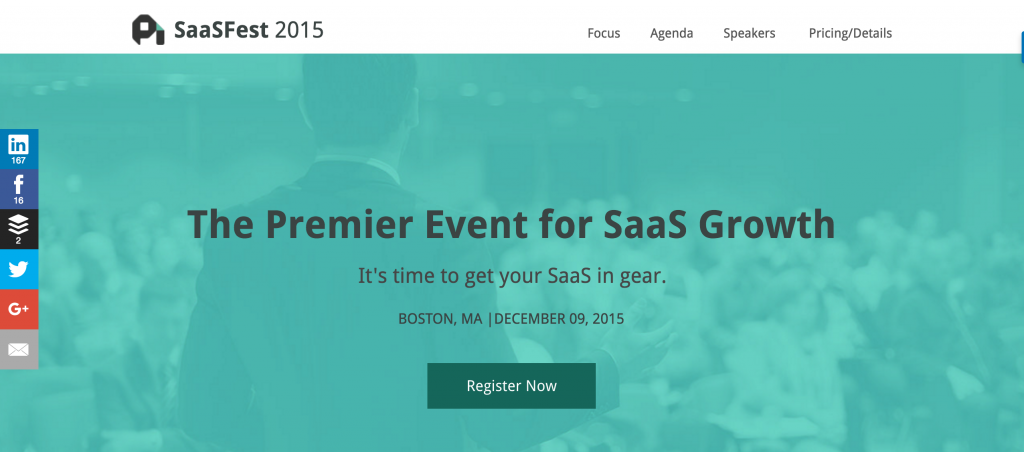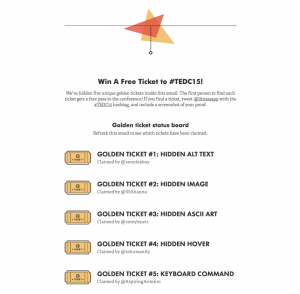
In 2011, not many people knew who Jason Lemkin was. Sure, he'd just sold his SaaS company to Adobe for a nice sum, but he didn't stand out from other successful entrepreneurs. Yet somehow, just four years later, he got a whopping 5,000 attendees to show up to his first ever SaaStr Annual Conference.
Lemkin's secret was content marketing. He joined Quora and started answering people's questions. He set up his website and started writing down all the stuff he wished someone had told him when he was building his company.
A few years of crafting genuinely useful content got him a bullet-proof brand in B2B tech. By answering founders' toughest questions, giving them actionable tips, and helping them solve the hard problems on the entrepreneurial journey, he earned deep credibility in the SaaS community.
So when he used content to promote his first event, attending felt like a no-brainer for those thousands of attendees.
That sounds like a pipe dream to most event marketers. But it's totally within your reach if you get an early start creating content that resonates with your target audience. Then, you can weave your event into that larger strategy and position it as something your audience is excited to be a part of.
Here are the five best content marketing tactics to get more attendees to your next event.
1. Blog Early and Often
Jason Lemkin's blog is the center of his content marketing strategy, so it makes perfect sense that he started promoting his first event with a blog post.
The post wins with its simplicity, telling readers the time, place, and why they should go: hands-on SaaS advice from top experts. It also creates urgency to commit now by emphasizing that there are only 100 discounted “early bird” tickets available.
Your blog is where you tell your audience how to solve the pressing problems in your industry and update them about what's happening at your company. The people who read it regularly are your biggest fans and best customers. They'll be the most interested in attending the event, so if you nail that first blog post announcing it, you'll get immediate ticket sales.
But don't stop there. There are plenty of other times and places you should be blogging about your event:
- Blog an announcement every time you book a new speaker or panelist.
- Ask those speakers to do a guest post on your blog promoting the event. Then, write your own guest post on their blog. It's a great way to expand your event's reach.
- Put up a blog telling readers when tickets are starting to run low.
Blogging lets you highlight the benefits of your event, get immediate ticket sales from your most dedicated audience members, and sustain interest in the months leading up.
2. Build the Event its Own Microsite
Your event needs one central hub where future attendees can learn everything they need to know and, of course, buy their ticket.
Your first instinct might be a landing page, but that isn't enough room to convey all the information your target audience needs. Sure, there's the simple stuff like time and location, but you also have to answer the most important question of all: Why should they go to this thing? Your event needs a compelling brand to draw people in.
A microsite is the best way to give your audience a full understanding of your event. Check out this one Price Intelligently created for SaaSFest, its yearly conference on how to grow a SaaS startup. It's nothing fancy, just one continuous page you scroll down. But it says everything you need to know.

The site is structured to drive visitors toward buying a ticket. It starts with a simple value proposition: This is an event for SaaS growth. If you run a SaaS startup, that would be enough to grab your attention. If that confirmed your initial interest, you'd keep scrolling to see the details.
The logic of the site is airtight: It starts by creating interest, then gives its target audience a way to act on it.
You'll link readers to your microsite whenever you mention the event in other pieces of content. So set it up as soon as you decide the event is on. Even if you don't have your speakers, venue, or even the date set yet, just get your microsite up and add to it as you go. You can use software such as Event Marketing Cloud from Glue Up that has the capability to create beautiful microsite event pages.
3. Run a Contest
Contests are a great way to get people excited about your event. After all, everyone wants to be a winner. But it won't work if your contest is just another Twitter sweepstakes that have been done a million times. It needs to be tailored to your audience and feel like a logical extension of your brand.

Email design company Litmus used a unique, one-of-a-kind contest to promote its event.
Inspired by Willy Wonka, Litmus used coding tricks to hide five golden tickets to the Email Design Conference inside an email promoting the event. The first person to find each ticket and tweet at Litmus with proof got to attend for free.
Litmus' contest was perfect for its audience. Litmus helps marketers design and send beautiful emails, and that's the focus of the conference as well. Anyone passionate about email design—the ideal attendee for the conference—was sure to get excited to look for those easter eggs. Recipients forwarded the email countless times, which expanded the reach for the event and helped Litmus sell out its early bird tickets in ten minutes.
Great contests aren't generic. Tap into your company's unique image or value-add to design a contest that'll be irresistible to your target audience.
4. Give Attendees a Say
Year in and year out, South by Southwest is one of the biggest, most successful media festivals in the world. It's nailed the art of producing a great event, but even SXSW doesn't plan the whole thing on its own. It uses its PanelPicker to let attendees submit topics they want to see covered by different speakers and vote for the most popular ones.
It feels like SXSW is doing attendees a huge favor. In a way, they are. But they're also encouraging attendees to send the PanelPicker around to their friends to get their favorite topic upvoted, widening the audience.
Your attendees are the people on the front lines of your industry wrestling with the tough issues every day. Giving them a voice ensures that your event covers the most pressing, timely topics.
But more importantly, giving attendees a sense of ownership over the event makes it feel more like a real community your company is bringing together, and not just a bunch of people who happen to work at similar companies.
You don't even need to create your own PanelPicker or let attendees vote. It's as simple as giving them a way to talk to you. You could set up a series of webinars before the event to give attendees a chance to tell you what they want to learn about.
5. Make a Video Preview
Customers love video content. Studies show that a video can boost a landing page's conversion rate by 80%. What's true for SaaS sites is also true for your event. If you've done events before, you probably have great footage from previous years that you can use to market this year's event.
No one knows the power of video marketing better than the experts at Wistia, so it's no surprise that video is a key part of how they promote their annual WistiaFest event.
WistiaFest has been going strong for three years now. That means Wistia has plenty of material from its previous conferences to create a video. This way target audiences can see what they can expect at the next 'Fest and why they should be excited.
If this is your company' first event, you could pull videos of your experts speaking at other conferences, or even get the team together and make your own promotional video. As hard as videos can be, the payoff can be huge. They engage more of the senses than the written word and let you show your audience what your event will actually look like.
Your Event Needs A Platform
Between the venue, speakers, and food, events are tough to put together. But if you only invest in the event itself, all of your hard work might be for nothing. You also need to build a brand for your event.
Content marketing is the best way to do it. These strategies enable you to pull in your core audience, reach new people, and enhance your company's image within your industry.
Of course, we could go on for hours about that, but why not just Book a Demo and talk with us for at least 15 minutes. We'd be more than happy to show you how Glue Up can fit into your next event and get you that 5000-person strong turnout you've always wanter.



